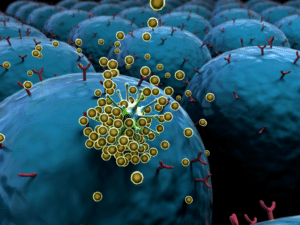Posted on November 18, 2019 in ASRC News, Structural Biology Initiative
Research by Professor Amédée des Georges at the Advanced Science Research Center could lead to longer lasting drugs that are less addictive and risky.
Preventing drug side effects, including addiction, heart failure, and impotence, has been an elusive goal for scientists. But a study published today in the journal Nature Structural and Molecular Biology could provide a breakthrough. The paper details how a growing understanding of G protein-coupled receptor signaling could allow developers to create therapeutic molecules that are both longer lasting and have fewer side effects.
Signaling by G protein-coupled receptors helps regulate physiological processes, such as heart rate, blood circulation, and emotions, but when unintentionally triggered by drug therapies, it can also cause a cascade of cellular activities that result in undesirable, even dangerous, side effects.

The research, co-led by scientists in the labs of Amédée des Georges at the Advanced Science Research Center at The Graduate Center, CUNY and Nobel Laureate Robert Lefkowitz at Duke University Medical Center, aims to help drug makers design molecules that are more fine-tuned in length and location of their action in patients. This mechanism would in effect trigger a targeted receptor in a very specific way that would reduce or eliminate potentially serious side effects. This ability could, for example, enable the development of a new class of therapies that prevent bone loss due to osteoporosis. It could also lead to longer-lasting pain medications that don’t cause addiction.
“This was a major collaborative effort,” said des Georges, a professor at The Graduate Center and The City College of New York and an expert in cryo-electron microscopy. The technique, awarded the Nobel Prize in Chemistry in 2017, enables scientists to create precise, 3D images of biological molecules, such as proteins, DNA, and RNA.
“This has been a very exciting project from the start, pushing the boundaries of cryo-electron microscopy to answer a fundamental question in biology that has important implications for medicine,” said des Georges.
The research was funded by the National Institutes of Health, the American Heart Association, Howard Hughes Medical Institute, and the pharmaceutical company Servier.
